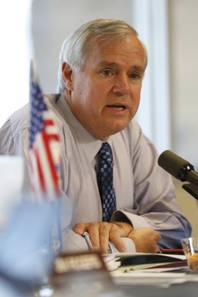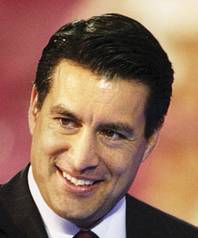
Students get help finding books at the UNLV bookstore during the first day of the fall semester at UNLV Monday, August 23, 2010.
Thursday, March 10, 2011 | 2 a.m.

Chancellor Dan Klaich

Neal Smatresk

Brian Sandoval
Sun archives
- UNLV president presents cuts, says they are “a tragic loss and a giant step backward for Nevada” (3-8-2011)
- Democrats say Sandoval budget has $325 million hole (2-24-2011)
- UNLV president’s somber warning on budget cuts moves faculty to tears (2-16-2011)
- Higher education officials say Sandoval budget cuts a ‘death sentence’ (2-4-2011)
- Education in forefront of upcoming budget battle (1-30-2011)
- Chancellor: University tuition would have to go up 73 percent to cover Sandoval budget gap (1-27-2011)
- A steep climb for Nevadans (1-26-2011)
- Soft words during State of the State hide Nevada in pain (1-25-2011)
- In response, Democrats say taxes might be part of budget solution (1-24-2011)
It’s more in anger than in sorrow when Victor Katz reflects on how the university where he taught for nearly four decades essentially went bankrupt.
Yes, the University of the District of Columbia somehow carried on despite the dismissal of a third of its faculty in 1997, he said. “But I don’t think you can call it surviving,” said Katz, 68, a mathematics professor who retired five years ago.
“A university is in constant need of new blood,” he said. “But the first to go were the junior faculty who were the most energetic. After a few years, the university lost a lot of credibility and it just was not recognizable.”
Nevada’s higher education system faces similar prospects. As it contemplates declaring financial exigency — a fiscal crisis requiring extraordinary solutions — big questions loom: If the ax falls because of the state’s budget crisis, how will it fall and on whom? Will the quality of education suffer? And if it suffers, will it recover?
There are no definitive answers, in part because Nevada’s System of Higher Education has never before declared such an emergency. And because there are no boilerplate solutions in how to address financial exigency, how it will play out is something of an improvisation.
But one thing is certain: If it comes to that, the fallout will be the biggest ever experienced in the nation. Nevada higher education’s two-year budget is about $1 billion, with 114,000 students spread over nine large campuses.
Exigency would allow the quick dismissal of professors, even those with tenure, and thus the faster reduction of costs. There are about 5,500 faculty, nearly two-thirds of whom are part-time. In 2010, they were paid $299 million, about 80 percent of which comes from state taxes.
Last month, UNLV said budget cuts proposed by Gov. Brian Sandoval would force it to consider exigency. Either the higher education system or a part, UNLV for instance, could declare the financial emergency. Dan Klaich, the higher education system chancellor, began asking college presidents to war-game drastic cuts, including the closing of their campuses. For example, one scenario would merge Nevada State College in Henderson into UNLV and/or the College of Southern Nevada.
Such moves would lead to whole programs and possibly entire campuses closing, especially in the more rural northern part of Nevada. Whether such mergers and closures would lead to students dropping out and a loss of overall enrollment is unclear, but such moves would lead to longer, less convenient commutes.
Klaich told the Board of Regents he was not recommending any of the scenarios.
The regents have final say, but won’t decide until the Legislature approves a budget in June.
The alarm was sounded again Tuesday when UNLV President Neal Smatresk announced the university must shut down 33 degree programs and cut 315 jobs, including 120 faculty positions, to deal with the state budget deficit.
Yet, Nevada’s exigency may not be the trauma that Katz recounts.
Ronald Ehrenberg, a Cornell University economist who studies the economics of higher education, said he doubts exigency is “even a black eye, if the faculty is involved from the very beginning in deciding about cuts and it’s not purely an administrative decision” by college presidents.
Exigency is similar to the way the bankruptcy code allows suspension of labor contracts to allow a business to reorganize under Chapter 11.
It wouldn’t necessarily be a death sentence, Ehrenberg said. “They’ll lose some of their best professors, but there won’t be wholesale departures,” he said.
The academic job market is bad nationwide and nearly all states are facing large budget deficits that mean big cuts in education, he added.
Colleges and universities in other states may declare exigency, too, so Nevada wouldn’t suffer alone. Moreover, the proportion of tenured professors and those on track to get tenure has declined to about a third of the academic workforce, down from more than half in 1975, the earliest year for which data are available. That means nontenured professors probably will be let go first, he said. But the danger is that some of a university’s best professors may be its junior professors, he said.
Unlike corporate bankruptcy, exigency is not settled law but more of a gentleman’s agreement between professors and the administration. In Nevada’s case, the regents would coordinate any declaration of exigency with campus presidents, who would in turn consult their faculty.
Every exigency is a special case. For example, City University of New York, with 200,000 students, underwent deep cuts in 1976. But no tenured professors lost their jobs during New York City’s brush with municipal bankruptcy.
Like New York City, the District of Columbia was in financial turmoil in the 1990s.
When the University of the District of Columbia, a public university, laid off a third of its faculty, many of them tenured, enrollment plummeted to 4,800 students from 7,500. While there was no official declaration of financial exigency, it was nonetheless treated as a financial emergency.
More than 13 years later, the university survives, but in diminished form. There are 5,900 students and 230 instructors, still down more than a third.
“We’re on the uptrend now,” said Steven Graubart, who has been the university’s senior financial officer for two years. He cited the current level of students, up from the year-earlier level of 5,000.
But the university gets by with even less public money, about $63 million today, down from $77 million in 1991.
“You have to take away from this situation,” referring to financial exigency, Graubart said, “a willingness to look at things with a fresh perspective” and do new things. For example, the university started a community college to boost enrollment, he said.
More recently, in 2009, Clark Atlanta University declared an “enrollment emergency” because of falling enrollment (but not exigency) and laid off tenured faculty. But unlike Nevada higher education, Clark Atlanta is private and received no state funding. The University of Texas Medical Branch in Galveston declared exigency in 2008 because of devastation from Hurricane Ike.
In all of the cases, professors challenged the subsequent dismissals.
Last year, Tulane University, hurt by Hurricane Katrina, considered exigency but pulled back when more state funding was found.
Nevada Regent Mark Alden favors declaring exigency if budget cuts remain at or near the level proposed by Sandoval.
“It’s nothing to fear,” Alden said. “We’d still make all of our bond payments, we’d still keep all of our obligations. Like corporate bankruptcy, exigency would allow the university to cut costs, free up cash and pay senior creditors, like bondholders.
“All it’s doing is suspending all contracts,” Alden said. “Then you’d have to tell people 60 days before you say goodbye. Without it, you might not be able to say goodbye at all” to a tenured professor.
The American Association of University Professors has largely defined exigency. The group, based in Washington, D.C., also developed the prevailing view of academic freedom and protection of professors from arbitrary dismissal.
The association defines financial exigency as an “imminent financial crisis which threatens the survival of the institution as a whole and which cannot be alleviated by less drastic means.”
Today, most colleges and universities have refined the idea from heading off a clear and present danger to something that is more precise. Exigency, according to the Nevada Regents’ handbook, means “a condition that requires the bona fide discontinuance or reduction in size of an administrative unit, project, program or curriculum due to the lack of funds available and sufficient to meet current or projected expenditures.”
Institutions that reorganize citing exigency must be careful not to be influenced by short-term concerns, such as whether a major is popular, Matthew Finkin, a leading labor law professor at the University of Illinois at Urbana-Champaign, said. After all, a major with faltering enrollment this year may become essential years from now, he said.

Join the Discussion:
Check this out for a full explanation of our conversion to the LiveFyre commenting system and instructions on how to sign up for an account.
Full comments policy